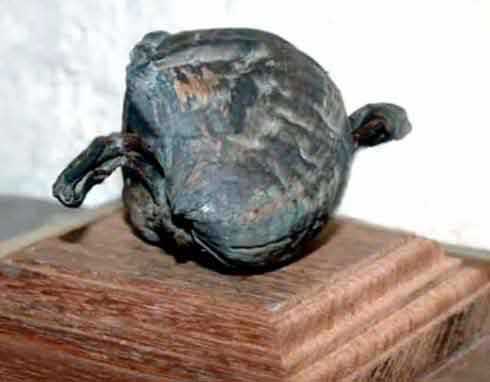Horned coconut - With two horns
India

So the captain arrogantly replied, “Does the coconut in the temple grove sprout horns?” and ordered his assistant to fetch those coconuts from the tree. The assistant on his command fetched the coconuts from the tree. Miraculously the tender coconut had three horns. The English Commander, realised his folly, fell to his knees and sought the Lord’s forgiveness.
Also he ordered the Government to pay 26 Salli Paisas daily to perform rituals and poojas at the temple. Even now our government is paying this amount for the temple. Visitors to the temple can view the three horned coconut, that hangs in front of the Amman Sanctum.
Sri Lanka
Il semble que la première description scientifique de cocotiers dit "à corne" date de 1924 et a été réalisée au Sri Lanka (Petch, 1924). Nous n'avons pas pu obtenir cet article pour l'instant.
French Polynesia
 |
| Cocotier à corne de l'atoll de Tetiaroa |
Petch, T. (1924) A horned coconut. Yearbook DoA, Ceylon pp 20-21.
Areca and Cocos in Andaman and Nicobar Islands. Indian J. For., 1979, 2, 350–363
Davis, T. S. (1965). Addition to the theories on the morphology of horns in coconut fruits.
Jerard, B. A., Niral, V., Dhanapal, R., Damodaran, V., Arunachalam, V., Rajesh, M. K., ... & Thomas, G. V. (2014). IND 221–Andaman Horned Cocos (IC0598221; INGR13063), a Coconut (Cocos nucifera) Germplasm with Distinct Character of Horny Nuts. Indian Journal of Plant Genetic Resources, 27(1), 76-77.
The 14 branches coconut palm from Maalhos island, Baa, in Maldives, an extinct world record...
 |
| Picture published by Afrah Mohamed |
 |
| The same palm photographed in 2014. |
Pora Pol coconut with hard and thick shells
 |
| Pora Pol coconut variety from Sri Lanka |
|
The Pora Pol
variety is disappearing. The first author of this site, Dr Roland Bourdeix,
together with a well known coconut scientist, Dr Lalith Perera, proposed to
create a conservatory of the Pora pol variety by replanting one of the small islands of Sri Lanka
according to the Polymotu concept. This project, initiated by the
Diversiflora International association, has unfortunately not yet
materialized. |
“It was a prominent part in Gammadu ceremonies where two or three months prior to holding Pattini pooja at Gammadu ceremonies, villagers engage in breaking Pora Pol. Like that they go on to crack thousands of nuts for weeks. As a kid I too have done it while in Matara and this was the starting point,” he says. Abeysinghe tells how people who engage in this ritualistic activity of cracking Pora Pol seeking divine blessings, become pure vegetarians months in advance. Playing Pora Pol takes place in the vicinity of a Devalaya and prior to commencing the game at an auspicious time, the Kapu mahattaya of the Devalaya engages in yathikawa (invocation)asking for divine blessings for the village as well for the safety of the players during the game. The reason why players are clad in full white is because it is an act of divinity, he says, adding that at the conclusion of the ceremony, the smashed coconuts are not consumed but used to produce oil for lighting the lamps.
essai
o
|
Dancing coconut eyes
Normal coconut have three eyes, or two eyes and one mouth
according to people perception and cultures. No more, no less; except if they
are coconut freaks...
|
|
|
|
|
|
|
|
|
|
|
|
|
|
|
|
|
|
|
|
|
|
|
|
|
|
|
|
|
A palm bearing about 5000 coconuts in the same time
A quite similar phenotype was observed by Dr R. Bourdeix in Tonga on a Compact Dwarf Coconut (Niu Leka type). I this case, the pollination process was not complete and most of the fruits were empty and came from a parthenocarpic developement.







